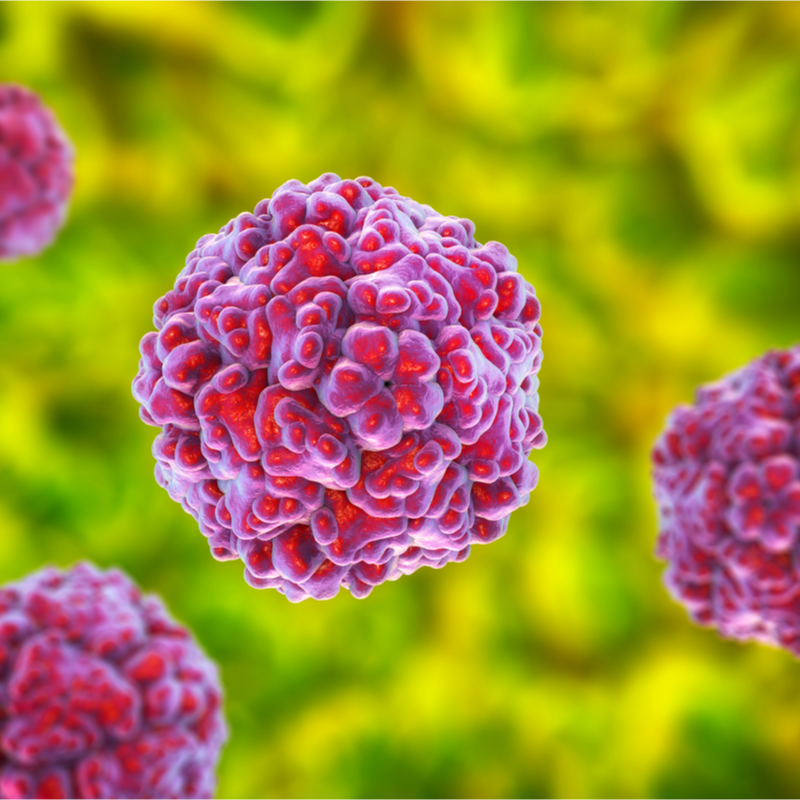
What is the rhinovirus?
Rhinoviruses are the pathogens that are causative for colds and runny nose. They belong to the family of Picornaviridae and are divided into 117 different serotypes to date. The viruses are spread all over the world and are restricted to humans. Since the rhinoviruses prefer a temperature between three and 33 degrees to reproduce, it is no wonder that infection numbers increase in wet and cold weather.
What is the morphology of the rhinovirus?
The genome of the virus consists of a positive single-stranded DNA. The virus particle does not have a viral envelope, but has an icosahedral capsid. The diameter of a rhinovirus is about 24-30 nm. Rhinoviruses are very sensitive to acid and prefer temperatures between 33 and 35 degrees.
How common is the rhinovirus?
They are the most widespread viruses and, with 50% of cases, the most common trigger for the development of a cold. However, the rhinoviruses are also associated with certain lower respiratory tract syndromes .
How is the rhinovirus transmitted?
The most common way of transmission is through smear infection, which means through contaminated hands or contaminated objects. Rather in rare cases, rhinoviruses are transmitted via droplet infection . The viruses become inactive within a few minutes due to drying in the dry air. Therefore, it is hardly possible for rhinoviruses to be transmitted to another person via sneezing or coughing . People with a weakened immune system or babies and small children are particularly at risk for infection with the rhinoviruses because they have not yet developed defences against more than 100 different rhinoviruses.
What are the symptoms of the rhinovirus?
The time between infection and the appearance of the first symptoms is about 1-4 days. An infection with rhinoviruses usually manifests itself as the following symptoms:
- Rhinitis,
- nasal congestion,
- Cough.
The following complaints may accompany the infection:
- general feeling of illness,
- Headache,
- Otitis media (especially common in children),
- Inflammation of the sinuses.
The body can only develop type-specific immunity for a short time. Therefore, with more than 100 serotypes, there is no sufficient protection against further infection with rhinoviruses.
How is the rhinovirus diagnosed?
In normal case, the diagnosis is made on the basis of the medical history and the physical examination. However, rhinoviruses can also be detected without a doubt with the help of a nasopharyngeal swab by means of an RT-PCR test . This test is carried out in an appropriate laboratory. However, it must be taken into account that a PCR test can often remain positive for a long time, even if the person affected no longer shows symptoms. Because of the many different serotypes, a serological examination is almost impossible. Making a diagnosis based on a cell culture is very inaccurate.
How is the rhinovirus treated?
A targeted fight against the viruses is not possible, but basically not necessary either, because the human defences and the body's own immune system can cope with the rhinoviruses all by themselves. As a rule, the body needs about a week to adapt to the viral pest. For this reason, this cold usually only lasts a week. As a rule, rhinoviruses do not cause any permanent damage to the nasal mucosa. The symptoms can be treated excellently with analgesics and antipyretics to make it easier to get through the infection.
What complications can rhinovirus lead to?
Rhinoviruses can lead to complications. Although most of these are not serious or even life-threatening, it is possible for a secondary bacterial infection to develop. The two most common complications of rhinoviruses are:
Sinusitis
Sinusitis is an inflammation of the nose and the mucous membranes of the sinuses. This is why this disease is also called rhinosinusitis. The following symptoms can occur:
- difficulty breathing through the nose,
- nasal congestion,
- impaired sense of smell,
- pressing pain in the area of the face,
- Fever,
- Headache.
A
sinusitis can be differentiated into an acute and a chronic
form. The acute form of rhinosinusitis can develop
several times a year and usually disappears again after a few
weeks. However, if the symptoms last longer than three months
, it is called chronic rhinosinusitis. If there is a
bacterial infection in the paranasal sinuses, the therapy
is carried out with the help of antibiotics. In addition, bed rest
should be observed and anti-inflammatory and pain-relieving medication
should be taken.
Otitis media
Otitis media is an inflammation of the middle ear. In this disease, the mucous membrane in the cavity of the middle ear and the tympanic cavity is inflamed. Otitis media can cause the following symptoms:
- sudden onset of ear pain,
- throbbing and knocking sounds in the affected ear,
- Dizziness,
- purulent and bloody discharge,
- Fever (especially common in young children),
- general fatigue and feeling of illness,
- Nausea with vomiting,
- in isolated cases, jaw pain.
In addition
to these symptoms, otitis media also shows the typical
signs of a cold, i.e. rhinitis and cough. Otitis
media should be cured with bed rest and, if necessary, with pain-relieving and
fever-reducing medication. In certain cases
special ear drops can be used, if necessary also with antibiotics,
.
How can you prevent rhinovirus?
To prevent infection with the rhinovirus, the following measures are essential:
- avoid large gatherings of people,
- ensure careful and thorough hand hygiene,
- avoid shaking hands.
